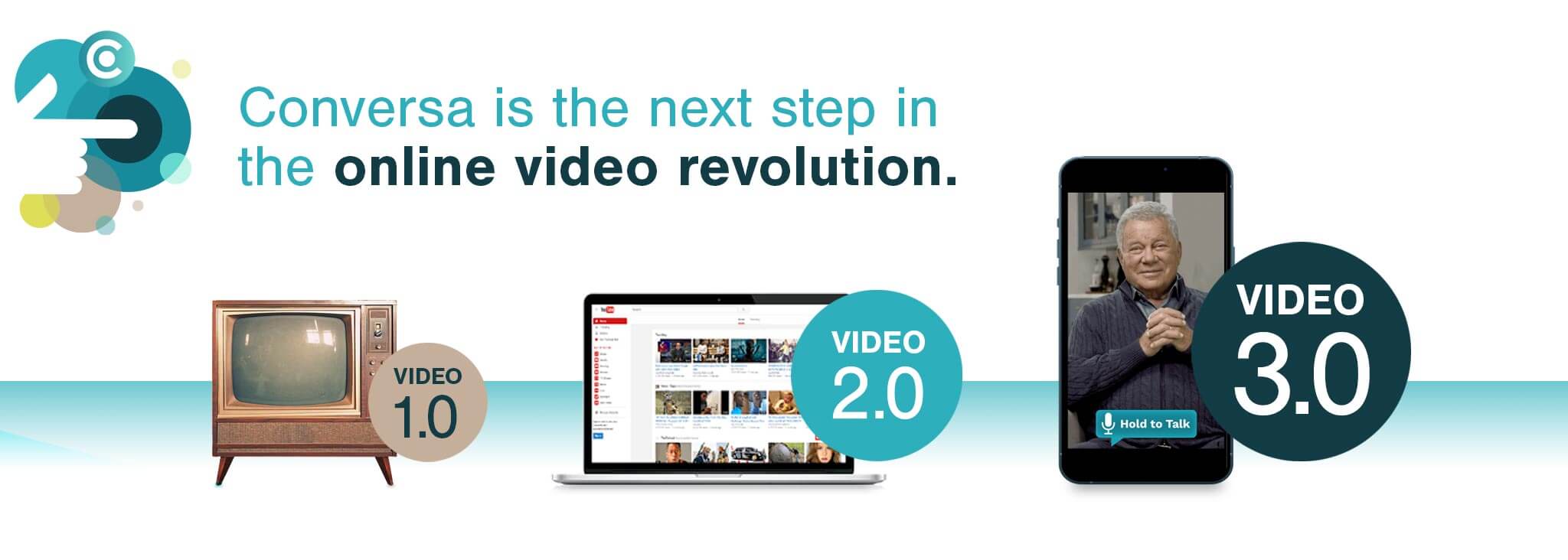
What is the celebration?
 By Stephen D. Smith, Chair & CEO, StoryFile
By Stephen D. Smith, Chair & CEO, StoryFile
Today StoryFile celebrates the official launch of our Conversational Video platform Conversa. Conversa is our patent-protected platform that provides tools to collect video, create and train AI interactions, and to publish anywhere on the web. We’re excited to introduce more audiences to our technology, as we believe Conversational Video has the potential to revolutionize the way we communicate and connect.
What is Conversational Video?
 Let’s take a step back. You might be wondering what Conversational Video is? Like the name suggests, Conversational Video combines two forms of communication we use everyday – conversation and video. Until now we have seen them as two distinct ways to communicate with one another. Put them together, and a new means of visual communication occurs. Let’s break this down.
Let’s take a step back. You might be wondering what Conversational Video is? Like the name suggests, Conversational Video combines two forms of communication we use everyday – conversation and video. Until now we have seen them as two distinct ways to communicate with one another. Put them together, and a new means of visual communication occurs. Let’s break this down.
Learn More About Conversational Video
Conversation is a personal speech-based way to collaborate with another living being who typically speaks the same language. It is an intimate form of communication that happens one-to-one or between a few people sharing the same interests or social space at the same time. We begin our lives learning to converse with parents, siblings, and friends. Language builds around the need to acquire knowledge and communicate it to others through conversation.
Video is a visual means to communicate information, ideas, and stories. Unlike conversation which requires a third party, video is a one way medium that can be consumed by many. An editor decides the sequence of images, narrative script, and any musical accompaniment. Once compiled, the video which is a linear medium can be started and stopped, skipped through and replayed but it is never changed, without the intervention of its author. With the advent of the Internet, video has become a tool for mass consumption. Millions of people can consume the same piece of information in different places.
Video 3.0 is here.

Now let’s put the two together. We take our instinctive curiosity to ask questions of other people, and we provide the ability to record videos with the answers to those questions. We also provide the interface for such conversations to take place anywhere at any time. This means that you can converse with real people who pre-recorded their answers, just like you would if you had a chance to meet them in person.
The science of Conversational Video requires complex computing which we refer to as our Artificially Intelligent Interactive Memory System (AIIMs). It is the means by which the content is first stored, then later retrieved from a number of possible answers to meet the curiosity of a future unknown conversationalist. The video is non-linear. By that, we mean that the video can branch in any number of pathways. Rather than a linear, sequenced narrative, Conversational Video feels like a person in conversation.
 The art of Conversational Video is found within the nuances of human behavior. The pre-recorded video contains the embodiment and emotions of the original source. For the subject to appear natural they also need to be able to respond with small talk and mannerisms that are appropriate for the conversation that is being conducted. In other words, the video does not only need to find the right answers, but look and sound natural too.
The art of Conversational Video is found within the nuances of human behavior. The pre-recorded video contains the embodiment and emotions of the original source. For the subject to appear natural they also need to be able to respond with small talk and mannerisms that are appropriate for the conversation that is being conducted. In other words, the video does not only need to find the right answers, but look and sound natural too.
Curiosity has ancient roots and is deeply embedded in our biology. Asking questions is at the center of human communication and has been with us for tens of thousands of years, influencing the way we connect as human beings.
 Asking questions is not only foundational to how we learn but instrumental to how we built our civilizations. Socrates introduced a conversational approach that has influenced psychology and education that encourages asking curiosity-filled questions.
Asking questions is not only foundational to how we learn but instrumental to how we built our civilizations. Socrates introduced a conversational approach that has influenced psychology and education that encourages asking curiosity-filled questions.
Recent science education research has found more generally that students that ask questions contribute to their own active knowledge development. Studies have shown that students retain 13.6% more knowledge when guided by questions (Rothstein & Santana, 2011). Formulating one’s own question is the single most essential skill for learning.
Conversation requires three skills. The first is to develop an appropriate question. For example, you might begin by asking someone, “Where do you go to school?” The second skill is to be able to listen and understand the conversation in context. Is the question about which school in particular, or the town in which the school is situated? We make assumptions based upon context. If the previous statement was “I am going to school in New York now”, the follow up question will be about which school in particular. If the previous statement was “I cannot wait to get back to school in the fall.” then “Where do you go to school?” would elicit “New York”, “NYU” or both. The third skill is being able to respond in real time in an ongoing branching cycle in which the information gained during the conversation informs what comes next.
Questions are not conversations in their own right, but drive conversation in the ways we navigate people, themes, and concepts within the world we live.
Unlike search questions on the Internet, conversational questions are not just about accessing data from one another. They also build relationships and trust. There has been more recent research linking question asking with likability and learning. In general, studies have revealed that people who ask more questions tend to be better liked. It also has a lot to do with the tone and type of questions asked, and the very human trait of having the opportunity to self-disclose or tell one’s story in a question.
What happens when we use our innate curiosity to learn and engage in conversation with another person? What if video could be a fixed but flexible source of information, inspiration, and insight?
At StoryFile we say that we are humanizing AI. It’s a big claim, but one based on a simple premise. The current rise in the use of chatbots and other text based conversational AI is based on the principle of extracting and providing information. The traits of human conversation which include listening, context, intonation, eye contact, physical embodiment and the emotions that go with sharing personally are not part of typical chatbots.
Conversational video is the future?
Conversational Video is a way to enhance chatbots and bring the human traits we use everyday to our work, our home, and our places of learning. After all, it’s in asking questions that we learn best.
Conversational Video is still in its infancy. At StoryFile we’re excited to see more and more audiences and businesses embrace the technology. You can review some of our current case studies here.
We will share more about our new Conversa platform in the coming weeks and months ahead. To go back to where we began, Conversa powers Conversational Video technology. The application is vast and has implications for education, corporate training, sales, museums, gaming, and many more industries that are invested in human connection and emerging technology.
Some Helpful Sources:
Lawson, Timothy J, James H Bodle, Melissa A Houlette, and Richard R Haubner. “Guiding Questions Enhance Student Learning from Educational Videos.” Teaching of psychology 33, no. 1 (2006): 31–33.
Brill, Gilat, and Anat Yarden. “Learning biology through research papers: a stimulus for question-asking by high-school students.” Cell biology education vol. 2,4 (2003): 266-74. doi:10.1187/cbe.02-12-0062
https://www.ncbi.nlm.nih.gov/pmc/articles/PMC256972/
Vale, Ronald D. “The value of asking questions.” Molecular biology of the cell vol. 24,6 (2013): 680-2. doi:10.1091/mbc.E12-09-0660
https://www.ncbi.nlm.nih.gov/pmc/articles/PMC3596240/
Christine Chin & Jonathan Osborne (2008) Students’ questions: a potential resource for teaching and learning science, Studies in Science Education, 44:1, 1-39, DOI: 10.1080/03057260701828101Rothstein, Dan, and Luz Santana. Make Just One Change : Teach Students to Ask Their Own Questions. Cambridge, Massachusetts: Harvard Education Press, 2011.




